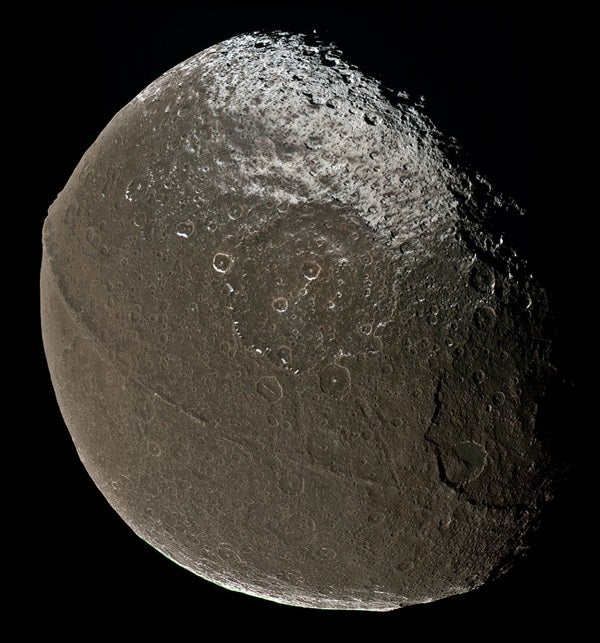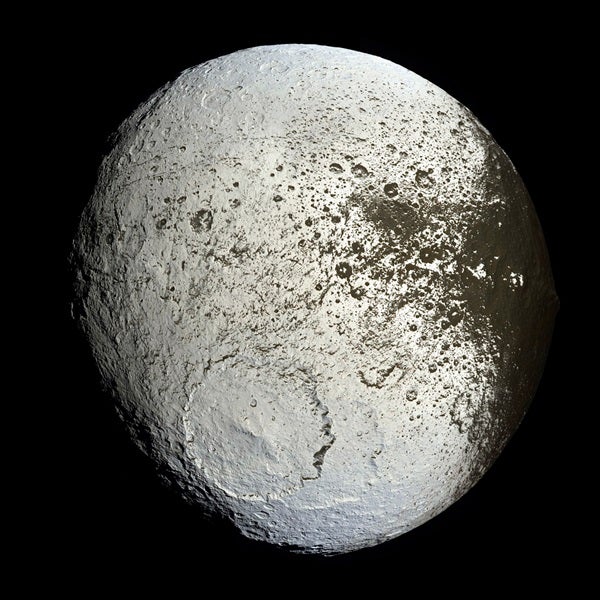Saturn’s third-largest moon makes our list for three good reasons. The first was obvious to Italian/French astronomer Giovanni Domenico Cassini soon after he discovered Iapetus in 1671, as it hovered on the right side of Saturn. After it slowly moved along its 79.3-day orbit and crossed over to the left side of the ringed planet, it vanished!

Bringing the universe to your door. We’re excited to announce Astronomy magazine’s new Space and Beyond subscription box – a quarterly adventure, curated with an astronomy-themed collection in every box. Learn More >>.
This bizarre behavior didn’t stop. Cassini kept watching, while his children grew up and gave him grandkids, and still he could see Iapetus only when it was on Saturn’s right, or western, side. Finally, 34 years later, as an old man with more money and a much better telescope, he at last dimly observed the satellite during the eastern half of its orbit. He realized this West Side Story must have a simple if odd explanation: Iapetus is five times brighter when on the west side of its orbit because it must have a locked-in rotation, meaning one side always faces Saturn, and that one half of its body is far darker than the other. To honor his correct reasoning, the inky hemisphere was later named Cassini Regio.
The visiting Voyager spacecraft in the early 1980s, and the orbiting Cassini spacecraft 20 years later, showed that Iapetus’ two utterly dissimilar hemispheres are separated by a bizarre yin-yang pattern — the kind of curve seen in the stitched sections of tennis balls. One is ice-covered and brilliant white while the other is blacker than an asphalt parking lot. This is the most striking hemispheric dissimilarity in the known universe, although other worlds do compete. (If an Earth globe is held in the proper orientation, one hemisphere is almost entirely blue ocean while the opposite side is mostly land. Also, our Moon’s nearside is dominated by dark blotchy “seas” while its far hemisphere has virtually none.) Nonetheless, the difference between the 12th-magnitude black side of Iapetus, the hemisphere that faces forward as the moon flies through space, and its 10th-magnitude white trailing half means that most backyard telescopes can easily spot the moon during only half its orbit.
Astronomers think dark material was originally deposited on Iapetus’ front side as it slammed through carbon-rich dust thrown off Saturn’s other outer moons when they were pummeled by meteors. Nowadays, the continued sublimation of ice from Iapetus’ warmer areas leaves a permanent residue of dark organic compounds. This carbonaceous matter seems to be only about a foot thick because meteor impacts break through to ice below.
In 2007, the Cassini orbiter was programmed to whiz just 1,000 miles (1,600 kilometers) above Iapetus’ surface. The images it captured showed that the black-white motif continues even at small scales, inside tiny impact craters. Strangely enough, this moon has no gray places.
Iapetus has the slowest spin of any Saturnian moon, and its 79.3-day rotation creates lengthy, warm days and long, bitterly cold nights. The sunlit ice turns directly to water vapor (a process called sublimation), and this vapor then gets redeposited in the cold areas. This model adequately explains the stark blacks and whites.
Unfortunately for astronomers, Iapetus’ second bizarre feature has no credible explanation at all — a raised ridge higher than Mount Everest that runs perfectly around its equator. This strange feature causes the moon to resemble a poorly made model globe whose two halves were glued sloppily, resulting in a raised equatorial band.
This equatorial ridgeline — 12 miles (20 km) wide and 8 miles (13 km) high — was discovered by the Cassini spacecraft on the last day of 2004. It is most uniform as it runs through Cassini Regio, the dark section, and includes individual mountains and parallel ridges. As it passes through Iapetus’ bright region, it shows itself as a series of separate peaks. Craters have impacted this raised equatorial feature, showing that it is ancient and not some recent tectonic uplift. It gives the yin-yang Enceladus the topographical appearance of a walnut.
Astronomers have made a few guesses about what could have caused such a band perfectly coincident with the equator, but all of these models have serious problems, and it remains one of the solar system’s mysteries.
A final oddity of Iapetus is its orbit. Although it is a substantial moon, it does not orbit around Saturn’s equator and ring plane like the others do. Because of this inclination, Iapetus is the only large moon that would offer good views of the planet’s magnificent rings; from all the others, the rings appear forever edge-on and look like a thin straight line. From Iapetus, Saturn appears the same size as Earth as seen from our Moon.
Unfortunately, Iapetus’ odd huge orbit makes it hard for the Cassini spacecraft to reach it. After the single close flyby September 10, 2007, there have been no others, nor are any planned, so it will be a while before we crack this walnut’s mysteries.











